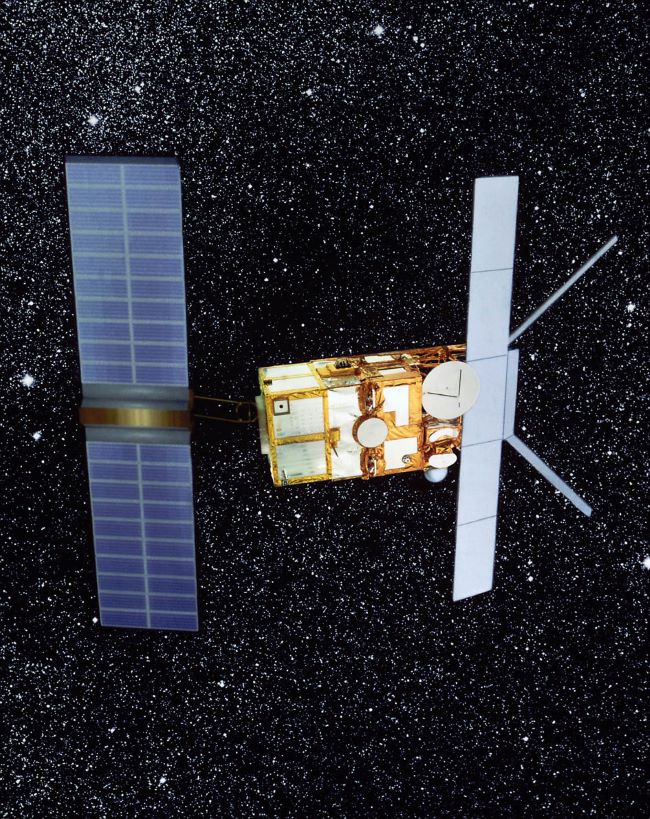
A big, dead satellite is set to crash back to Earth sometime next week. The European Space Agency (ESA) satellite was a scientific Earth-monitoring mission called ERS-2. Because the agency has no way to control its reentry (what they call a “natural” reentry), the window for when ERS-2 will hit Earth isn’t precise. As we get closer to reentry, the window narrows, and ESA’s latest prediction is a reentry at 00:24 UTC on Wednesday, February 21, 2024 (or 6:24 p.m. CST, Tuesday, February 20), with an error margin of plus or minus one and a half days. But ESA is frequently updating this time range, so check here for the latest.
During a press conference on February 13, ESA said:
We estimate that the largest fragment of the satellite that could reach the ground is 115 pounds (52 kg).
But it also said:
The odds of a piece of satellite falling on someone’s head is estimated at one in a billion.
So, when you consider that 71% of Earth’s surface is water, odds are likely that the satellite will make a big splash somewhere.
EarthSky lunar calendars are back in stock! And we’re guaranteed to sell out, so get one while you can. Your support means the world to us and allows us to keep going. Purchase here.
What is ERS-2?
ERS-2 is ESA’s second European Remote Sensing satellite. Launched on April 21, 1995, the satellite had a 16-year career observing Earth until ESA retired it in 2011. In July and August of that year, the space agency directed the satellite in 66 maneuvers to assist with deorbit. The maneuvers used up the satellite’s fuel in order to decrease its orbit and lessen its chance of hitting operational satellites. Lowering the satellite’s orbit also ensured that the satellite would reenter within the next 15 years, instead of 100 to 200 years. By September 2011, all the fuel from ERS-2 drained. So now the spacecraft is inoperable.
Over the satellite’s lifetime, ERS-2 collected data on polar ice, changing land surfaces, sea-level rise, warming oceans and atmospheric chemistry. It was also pressed into service during natural disasters in remote regions. ESA said ERS-2:
… returned a wealth of information that revolutionized our perspective of our planet and understanding of climate change. As well as leaving a remarkable legacy of data that still continue to advance science, this outstanding mission set the stage for many of today’s satellites and ESA’s position at the forefront of Earth observation.
Reentry of a dead satellite
ERS-2 weighs approximately 5,057 pounds (2294 kg). ESA said that:
On average, an object of similar mass reenters Earth’s atmosphere every week or two.
The space agency said that the satellite will begin to break up when it reaches about 50 miles (80 km) above the ground. Most of the fragments will burn up completely in Earth’s atmosphere. But some pieces could reach Earth’s surface. The risk to humans is minute. According to ESA:
The annual risk of an individual human being injured by space debris is under 1 in 100 billion.
And what does the burning spacecraft do to our atmosphere? While ESA said:
… the short-term impact on the atmosphere due to the burn up of a single spacecraft is modest.
But, as ESA said, an object this size reenters every week or two. And in October 2023, a team of scientists released a study that said:
… about 10% of the aerosol particles in the stratosphere contain aluminum and other metals that originated from the “burn-up” of satellites and rocket stages during reentry. Although direct health or environmental impacts at ground level are unlikely, these measurements have broad implications for the stratosphere and higher altitudes. With many more launches planned in the coming decades, metals from spacecraft reentry could induce changes in the stratospheric aerosol layer.
Meanwhile, stand by for more updates on the reentry of ERS-2.
Bottom line: ESA’s satellite ERS-2 should crash into Earth between February 19 and 23, 2024. The dead satellite is on an uncontrolled, or “natural”, reentry.
Via ESA